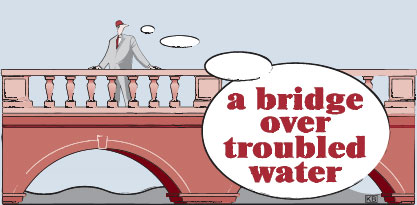Bridges are a normal part of every urban and rural environment and for centuries they have had a substantial impact on the development of civilization, influencing trade, cultures and lifestyles. With the advance of technological progress, the natural materials available in the area have been replaced with more advanced ones, spans have lengthened considerably and bridges have became more sophisticated both in construction and design.

Mosty są nieodłączną częścią krajobrazu a przez lata miały istotny wpływ na rozwój cywilizacyjny, ułatwiając handel, pomagając w krzyżowaniu się kultur i stylów życia. Wraz z rozwojem technologicznym, mosty bardzo zmieniły się pod względem wykorzystywanych materiałów budowlanych, konstrukcji i wzornictwa.
The purpose of a bridge is to create a passageway over natural and artificial obstacles like rivers, gorges, valleys, roads and railway tracks. The width of the obstacle often determines the type of bridge construction, the most popular of which are beam bridges, cantilever bridges, arch bridges, suspension bridges, cable-stayed bridges and truss bridges.
Arch bridge
An arch bridge is a type of bridge in which the weight is carried outward along the curve to supports at each end. It has great natural strength and is made mostly of steel or concrete.
The Sydney Harbour Bridge was opened in 1932 after a six-year construction period. It is 134 metres high and 1149 metres long, which makes it the largest, though not the longest, steel arch bridge in the world. The bridge contains 6 million hand driven rivets and enormous hinges at the footings of the pylons to absorb the thermal expansion caused by the Australian heat; the weight of steelwork is 52,800 tons. The bridge is beautifully located in Sydney Harbour and has become one of the internationally recognised landmarks of Australia.
Cable-stayed bridge
A cable-stayed bridge is a bridge in which the roadway deck is suspended from cables anchored to one or more towers erected above piers in the middle of the span.
One of the world’s longest cable-stayed bridge, the Akashi-Kaikyo Bridge, is located in Japan, connecting Kobe on the mainland with Awaji on Awaji Island. It is an impressive three-span bridge, 282.8 metres high and 3910 metres long with a central span of 1990 metres. This modern nine-year-old bridge system has a wind-proof and earthquake-resistant construction with a two-hinged stiffening girder, and its building materials include high-tensile galvanised steel and pioneering underwater concrete.
truss/cantilever bridge
A truss/cantilever bridge is a projecting structure supported by a beam that is anchored at one end and unsupported at the other end. It consists of an assembly of triangles, made from a series of straight, steel bars. Rigid arms extend from both sides of two piers.
The Forth Railway Bridge, opened in 1890, is an outstanding cantilever structure and a renowned international engineering symbol of Scotland. It is 2.5 kilometres long, and its two main spans are 521.3. The construction involved the use of 54,000 tonnes of steel and the driving of 6,500,000 rivets. The bridge, with its three huge cantilever towers, still remains a vital part of the regular railway infrastructure.
Suspension bridge
A suspension bridge is a structure in which the roadway is hung from strong cables that pass over two towers. Most suspension bridges have a truss system beneath the roadway to resist bending and twisting.
The Brooklyn Bridge, is not only a widely recognizable structure but also a legendary icon of New York, offering spectacular views of the harbour and Manhattan. Completed in 1883, it is 83 metres high and 1834 metres long, with the longest span of 486.3 m. The bridge is built from limestone, granite, and natural cement, hung on suspender cables.
 Uzupełnij poniższe zadania
Uzupełnij poniższe zadania
następującymi wyrazami: rivet, hinge, pylon, span, suspender cable.
a) ………………..pylon carries the weight of the deck
b) ………………..hinge connects two solid objects.
c) ………………..rivet is put in a pre-drilled hole.
d) ………………..span is a section between two supports of a bridge.
e) ………………..suspender supports structures for suspension bridges.
 Dopasuj rodzaje mostów
Dopasuj rodzaje mostów
do kojarzących się z nimi grup wyrazów.
viaductwiadukt, jetwayrękaw (korytarz łączący poczekalnię z samolotem), aqueductakwedukt, flyover / overpasskładka dla pieszych, estakada, skywaypasaż pomiędzy budynkami
a) ………………..skyway buildings, pedestrians
b) ………………..viaduct cars, trains, valley, road, railroads
c) ………………..jetway corridor, airport, aircraft
d) ………………..flyover/ overpass crossing, motorway, pedestrians
e) ………………..aqueduct pipe, channel, water
Gramatyka: Odrobina teorii – Comparison of adjectives
{mospagebreak}
 Porównaj mosty, stosując stopień wyższy
Porównaj mosty, stosując stopień wyższy
a) Akashi-Kaikyo Bridge – Brooklyn Bridge – advanced ……………………………..Akashi-Kaikyo Bridge is more advanced than Brooklyn Bridge
b) Sydney Harbour Bridge – Forth Railway Bridge – heavy……………………………..Forth Railway Bridge is heavier than Sydney Harbour Bridge/ Sydney Harbour Bridge is less heavy than Forth Railway Bridge.
 Porównaj mosty stosując stopień najwyższy:
Porównaj mosty stosując stopień najwyższy:
c) Akashi-Kaikyo Bridge – Brooklyn Bridge – Sydney Harbour Bridge – Forth Railway Bridge – old……………………………..Brooklyn Bridge is the oldest (of all)
d) Sydney Harbour Bridge – Akashi-Kaikyo Bridge – Brooklyn Bridge – high……………………………..Akashi-Kaikyo Bridge is the highest.
Study tip!
Ucząc się języka angielskiego samodzielnie, dobrze jest urozmaicić pisemne ćwiczenie i utrwalanie poznawanego materiału – słownictwa i gramatyki. W tym celu można np. prowadzić pamiętnik, dziennik, w którym będziemy zapisywać nasze doświadczenia, przemyślenia, używając przy tym np. trybów warunkowych, mowy zależnej, itp. Podobne ćwiczenie mozna również przeprowadzać z kolegą, współpracownikiem, umawiając się, że cała służbowa czy prywatna korespondencja będzie prowadzona w języku angielskim.

Aneta Kapron
Artykuł zamieszczony
w „Inżynierze budownictwa”,
wrzesień 2007.





